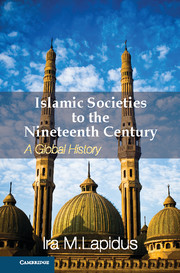Book contents
- Frontmatter
- Contents
- List of Illustrations
- List of Figures
- List of Maps
- List of Tables
- Preface
- Acknowledgments
- Acknowledgments to the first edition of A History of Islamic Societies
- Acknowledgments to the second edition of A History of Islamic Societies
- Publisher's Preface
- Introduction to Islamic Societies
- Part I The Beginnings of Islamic Civilizations
- The Middle East from c. 600 TO c. 1000
- The Preaching of Islam
- The Arab-Muslim Imperium (632–945)
- Cosmopolitan Islam: The Islam of The Imperial Elite
- Chapter 11 Introduction: Religion and Identity
- Chapter 12 The Ideology of Imperial Islam
- Chapter 13 The ʿAbbasids: Caliphs and Emperors
- Urban Islam: The Islam of Scholars and Holy Men
- Women, Families, and Communities
- Part II From Islamic Community to Islamic Society
- Part III The Global Expansion of Islam from the Seventh to the Nineteenth Centuries
- Glossary
- Bibliography
- Annotated Bibliography from A History of Islamic Societies, 2nd Edition
- Index
Chapter 11 - Introduction: Religion and Identity
Published online by Cambridge University Press: 05 February 2013
- Frontmatter
- Contents
- List of Illustrations
- List of Figures
- List of Maps
- List of Tables
- Preface
- Acknowledgments
- Acknowledgments to the first edition of A History of Islamic Societies
- Acknowledgments to the second edition of A History of Islamic Societies
- Publisher's Preface
- Introduction to Islamic Societies
- Part I The Beginnings of Islamic Civilizations
- The Middle East from c. 600 TO c. 1000
- The Preaching of Islam
- The Arab-Muslim Imperium (632–945)
- Cosmopolitan Islam: The Islam of The Imperial Elite
- Chapter 11 Introduction: Religion and Identity
- Chapter 12 The Ideology of Imperial Islam
- Chapter 13 The ʿAbbasids: Caliphs and Emperors
- Urban Islam: The Islam of Scholars and Holy Men
- Women, Families, and Communities
- Part II From Islamic Community to Islamic Society
- Part III The Global Expansion of Islam from the Seventh to the Nineteenth Centuries
- Glossary
- Bibliography
- Annotated Bibliography from A History of Islamic Societies, 2nd Edition
- Index
Summary
The delineation of Arabic-Islamic religion and culture and Muslim identities was a centuries-long process. Its social basis was the integration of Arab-Muslim, convert, and non-Muslim populations in the cities founded or settled by the Arab-Muslims. Mecca, Medina, Damascus, Kufa, Basra, Baghdad, and other cities were the homes of new Islamic societies that integrated the cultures of Arabia and the conquered peoples. The new civilization amalgamated Arabian language, poetry, and religion and late antique imperial symbols and literary and artistic cultures, as well as Jewish, Christian, and Zoroastrian religious values and family and communal institutions.
Islamic identities developed only slowly, and some scholars have questioned if there was a “Muslim” identity at all in the years after the death of Muhammad. If not, when did a Muslim identity come into being? One theory is that the conquerors first identified themselves not as Muslims but as a community of believers, a coalition of peoples of faith fighting the enemies of God. They were an assembly of monotheists, and the people of each faith had their own book and their own laws. Only after a century did they accept Muhammad as their prophet and the Quran as their holy book. The idea of a multireligious community was indeed implied in Muhammad's early teaching, but with the struggles for power in Medina and the exile or execution of the most powerful Jewish clans, it is not likely that this concept lasted even to the end of Muhammad's life. In Medina, the revelation of new ritual and family laws and of a sacred Arabian history for Muslims already implied the beginnings of a separate communal identity.
- Type
- Chapter
- Information
- Islamic Societies to the Nineteenth CenturyA Global History, pp. 114 - 116Publisher: Cambridge University PressPrint publication year: 2012
- 1
- Cited by



